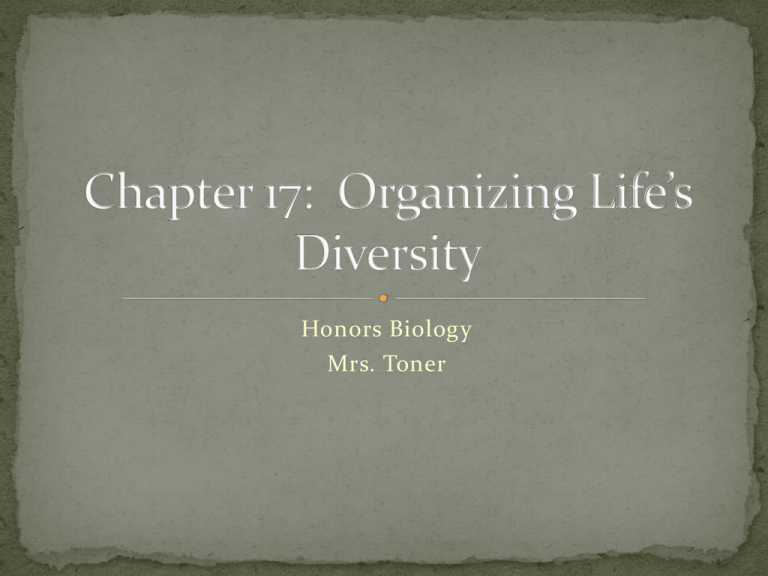Chapter 17: Organizing Life*s Diversity
advertisement

Honors Biology Mrs. Toner 1. How is classification used every day? 2. Why do scientists organize or classify living things? 3. Do you know the scientific names of any species? Biologists use a system of classification to organize information about the diversity of living things. Just as stores group CDs according to type of music and artist, biologists group living things by their characteristics and evolutionary relationships. Classification – is the grouping of objects or organisms based on a set of criteria. Biologists find it easier to communicate and retain information about organisms when the organisms are organized into groups. One of the principal tools for this is biological classification. Aristotle’s System Greek philosopher , Aristotle (394-322 B.C.) Developed the first widely accepted system. Classified organisms as either plants or animals. See page 484 Table 17.1 Aristotle’s Classification System Limitations of Aristotle’s System: Viewed systems as being distinct, separate, and unchanging. This was a common view until Darwin presented his theory of evolution which stated that organisms are always changing. Organisms share evolutionary relationships. Nevertheless, many centuries passed before Aristotle’s System was replaced by a new one that was better suited to the increased knowledge of the natural world. Linnaeus’s System: Linnaeus (Swedish Naturalist, 1707-1778) Broadened Aristotle’s classification method Concentrated on morphology and behavior of organisms Categorized birds into three major groups (see page 485, Figure 17.1) Linnaeus’s system of classification was the first formal system of taxonomic organization. Taxonomy – is a discipline of biology primarily concerned with identifying, naming, and classifying species based on natural relationships. Linnaeus’s method of naming organisms called binomial nomenclature – gives each species a twopart name: genus and species Latin Cardinalis cardinalis Species and Genus (Created by Linnaeus) Taxon – a named group of organisms (plural, taxa). Range from having broad diagnostic characteristics to having specific characteristics. Think of taxa as a set of nesting boxes – one fitting inside the other. (See page 488, Fig. 17.4) Domain Kingdom Phylum Class Order Family Genus Species Species – a group of organisms that can interbreed and produce offspring. [Ursus americanus (American black bear), Ursus thibetanus (Asiatic black bear)] Genus – (pl. genera) a group of species that are closely related and share a common ancestor. (Ursus = black bear) Family – is the next higher taxon, consisting of similar, related genera. (Ursidae = all bears, both living and extinct; brown bears, polar bears, giant pandas) All members of the bear family share certain characteristics. They walk flatfooted, have forearms that can rotate to clasp prey. Order – contains related families Class – contains related orders Phylum – (pl. phyla) or division (bacteria and plants) contains related classes Kingdom - the taxon composed of related phyla or divisions Domain – the broadest of taxa. ACTIVITY: Classify a giant panda, Ailuropoda melanoleuca, completely from domain to species level by referring to Figure 17.4. Eukarya, Animalia, Chordata, Mammalia, Carnivora, Ursidae, Ailuropoda, melanoleuca Determining Species – the definition of species has “evolved” over the years. Typological Species Concept Biological Species Concept Phylogenetic Species Concept Phylogeny – the evolutionary history of a species. Shows evidence of a pattern of ancestry and descent. To classify a species, scientists often construct patterns of descent, or phylogenies, by using characters. Characters – inherited features that vary among species. Characters can be: Morphological - similarity in anatomy Example – Darwin’s Finches Biochemical (Molecular) - similarity of nucleic acids (DNA) and amino acids (proteins) Developmental - similarity in developmental patterns Behavioral – similarity in vocalization or mating behaviors The evolutionary history of a species or group of related species. Organizes organisms based on their history and relation to one another. A phylogenetic tree (or evolutionary tree) is a graphical hypothesis of the proposed phylogeny. A phylogenetic tree is often called a cladogram. A cladogram is a branching diagram that represents the evolutionary history of a species. Cladistics – a method that classifies organisms according to the order that they diverged from a common ancestor. Clade Node


